Scout Report: Iván Román is Chile’s defensive star of the future
- Nathan Joyes
- Sep 17, 2024
- 10 min read
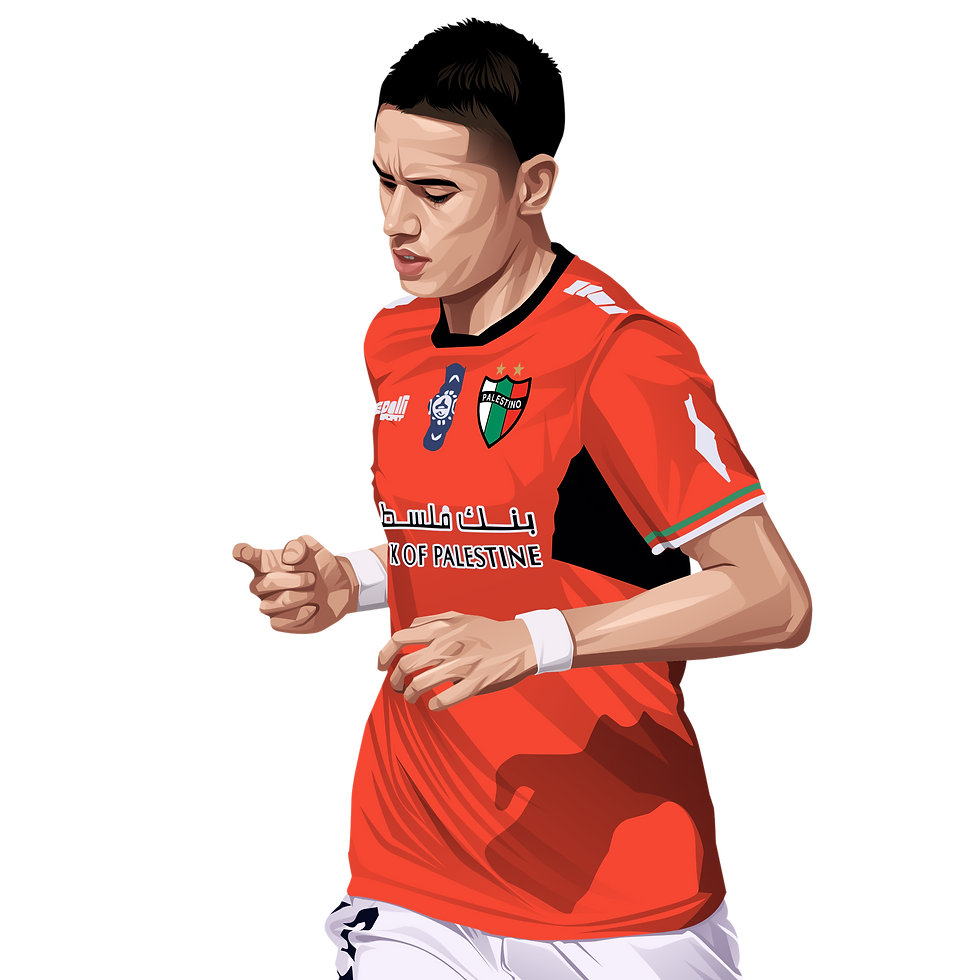
South American football has long been a breeding ground for exceptional young talent. Clubs across the continent are experts at nurturing these players, giving them the chance to shine in first-team football.
Meanwhile, European clubs keep a close watch, always on the lookout for those promising young stars who might be ready to make the leap across the Atlantic.
It’s true that Brazilian, Colombian, and Argentinian clubs are often the most recognised for their youth development. But it’s important to remember that clubs all across the region are just as committed to giving young talent the chance to play at the highest level.
In this scout report, we’re heading to the west coast of South America, focusing on Chile, as our spotlight is on 18-year-old central defender Iván Román.
Since breaking through in 2023, this Chilean youth international has firmly established himself as a first-team regular having already racked up over 2,600 minutes of playing time for Club Deportivo Palestino this year, delivering some standout performances along the way.
We will delve into both data and in-game analysis to uncover what makes Iván Román such an exciting prospect in South American football and demonstrate why he is one to watch.
Iván Román: Percentile rankings

The pizza chart allows us to begin developing an overall picture of Iván Román’s style of play.
We can see that Román ranks in the 71st percentile for PAdj interceptions suggesting that he is an intelligent defender who is capable of positioning himself well to break up opposition attacks.
He ranks lower in PAdj sliding tackles, indicating he is more proactive than reactive. When a defender ranks highly in terms of sliding tackles there is always a concern that they are forced into the tackle as a result of them being slow to react and not engaging in a defensive action until it is too late and the play has moved beyond them.
Román is in the 93rd percentile for progressive passes which allows us to infer that he looks to play line-breaking passes, possibly in the attacking transition as CD Palestino looks to counterattack.
Furthermore, his pass accuracy is lower than average, this is potentially due to his propensity to play these progressive passes which are riskier and more likely to be intercepted by the opponents.
From this, we can infer that the 18-year-old is a player who enjoys being on the ball and attempts to be creative in possession, looking to progress his team forward.
Data analysis
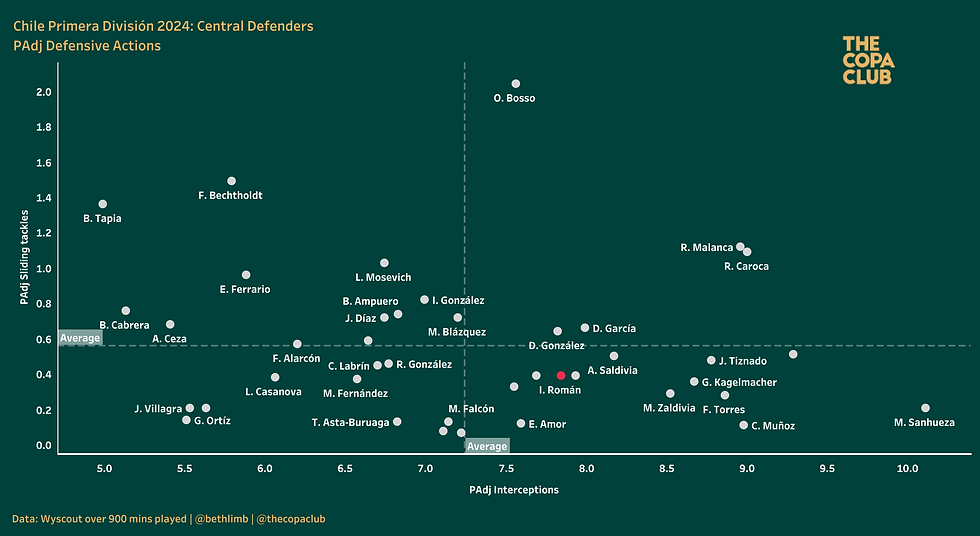
Here, we can see how well Román performs in his defensive actions compared to his fellow central defenders in the Chilean Primera División.
The 18-year-old averages 7.84 PAdj interceptions and 0.39 PaAdj sliding tackles per 90. The viz shows that he is performing above average regarding interceptions and slightly below average for sliding tackles.
Having a central defender who is confident in making interceptions means he is much less likely to give away needless fouls in dangerous areas. Additionally, this suggests he has excellent tactical awareness and positioning to break up opposition attacks and passing sequences.
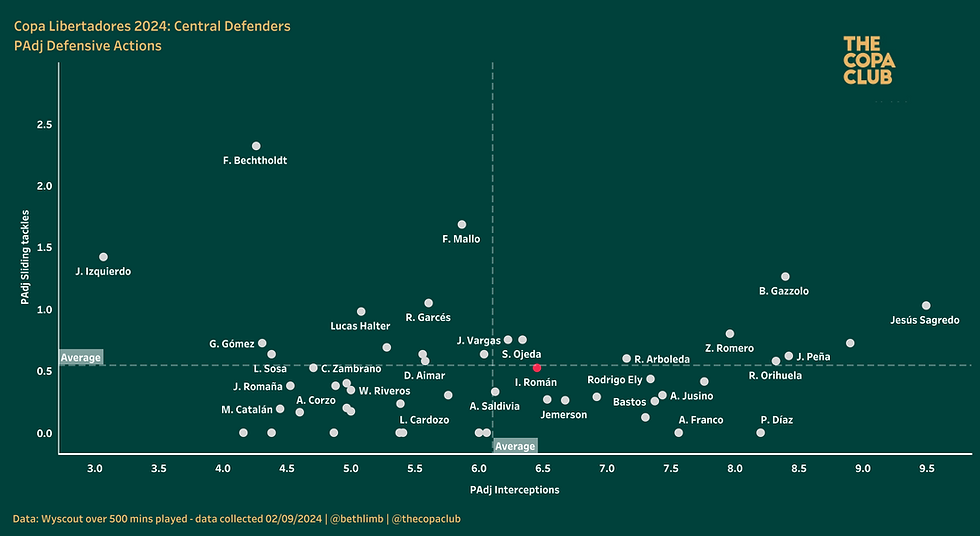
Moreover, there’s a similar story when looking at how Román compares to central defenders in the 2024 Copa Libertadores. In this competition, he averaged 6.45 PAdj interceptions and 0.53 PAdj sliding tackles per 90, aiding Palestino’s third-place finish in Group E.
This second data viz shows us that he does not change his style when playing in big continental games, suggesting he is a brave defender who is committed to playing a certain way.

Here, we can see how well Román performs in terms of his defensive duels, averaging 7.43 per 90, with a win percentage of 71.93%. This infers that he is a physically strong defender who does not shy away from a duel with an opponent.
As he consistently wins these defensive duels, it means Román provides a solid foundation for Palestino’s defence. His ability to win 1v1 battles reduces the chances of the opposition breaking through the defensive line.
Winning his duels can often mean that the young defender recovers possession (he averages 10.16 recoveries per 90). This can be crucial in transitioning from defence to attack, particularly if Palestino are looking to launch rapid counter-attacks.
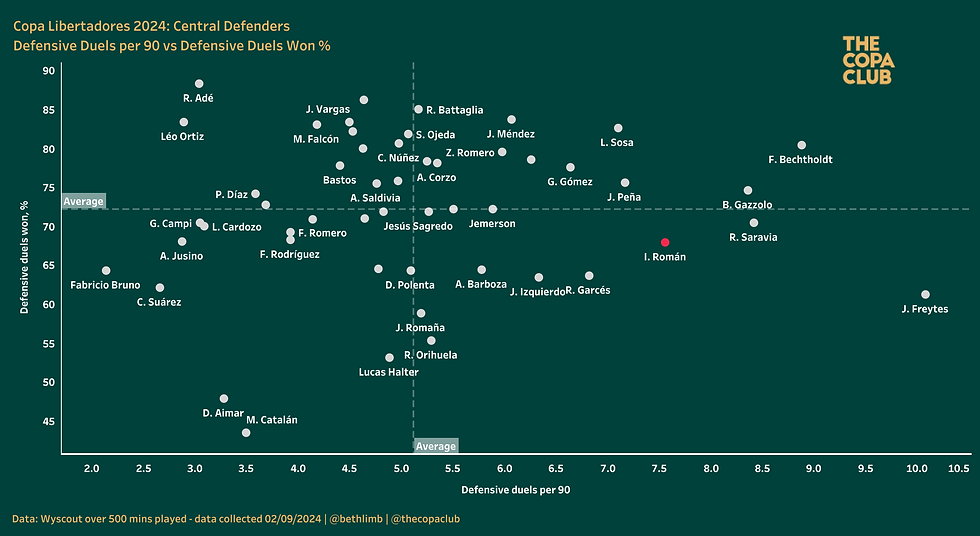
Turning our attention to the same metrics for the Copa Libertadores, we can see that Román still performed above average for the number of defensive duels per 90 (7.56). However, his win rate of 67.86% means he was below average compared to his fellow centre backs in the competition.
This is not unexpected, nor is it anything to be concerned about. An important factor for this is that in the Copa Libertadores, Román faces the best forwards from across the continent who may be physically stronger than him or simply have a higher capability of winning ground duels.
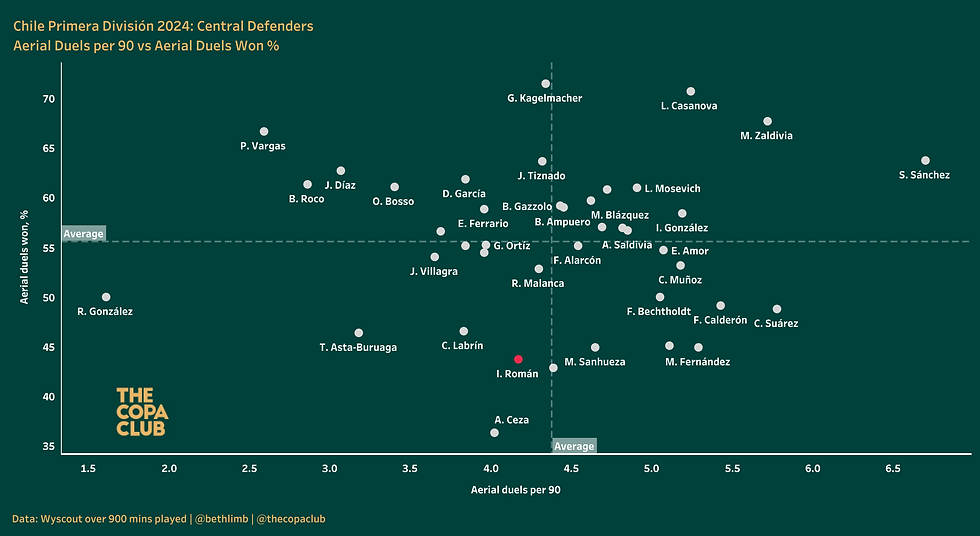
Conversely, we can conclude that the Palestino defender does not do well in the aerial battles. He is performing below average in terms of both the number of aerial duels he enters into and the amount he wins compared to fellow central defenders in Chile.
The Chilean averages 4.17 aerial duels per 90, winning 43.74% of them. There are some reasons why Román may be ranking lower than many of his counterparts in these metrics.
One of which could be down to tactical factors. For example, if Palestino plays a high defensive line, he may be more focused on tracking an opposition runner or maintaining his position.

It comes as no surprise to see that Román was below average aerially during his performances in the Copa Libertadores as well. He averaged 3.24 aerial duels per 90 with a 41.67% win rate during his time in this year’s competition.

A central defender is not just expected to perform well defensively, modern football typically requires a central defender to be able to progress the play for their team. Based on the data, this is certainly an area where Iván Román excels for Palestino.
Domestically, he is averaging 10.37 progressive passes per 90 and 1.11 progressive runs per 90. This suggests that Román is not only a player who actively looks to play line-breaking passes on a regular basis, but is also happy to carry the ball forward himself.
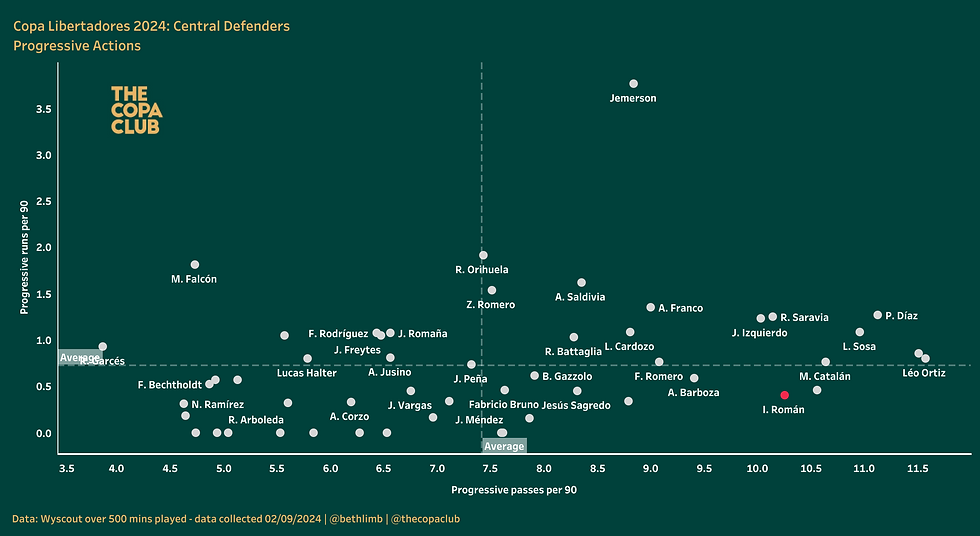
Furthermore, we can see here that Román was also above average with his progressive passing output in the Copa Libertadores this year. He averaged 10.25 progressive passes per 90, indicating he plays a key role in Palestino’s build-up play.
However, he was below average with his progressive runs (0.4 per 90). This is to be expected when taking part in a competition against much stronger opponents. Román most likely had more defensive responsibilities, meaning he had to hold his position and not necessarily pick the ball up looking to carry it forward.
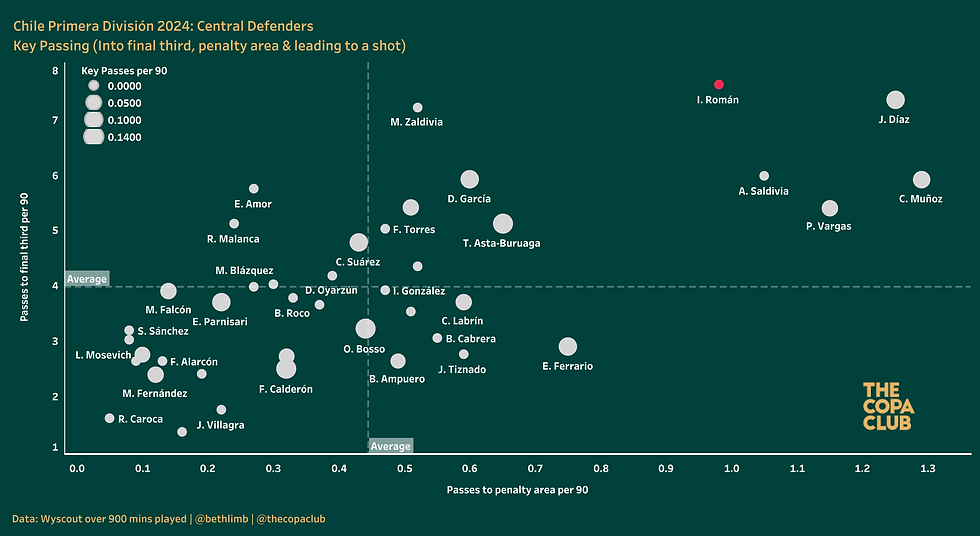
In this final section of our data analysis, we will look at how well Iván Román performs regarding his key passing. This visual shows us that he averages 7.63 passes into the final third per 90 and 0.98 passes into the penalty area per 90. This further ties in with what we know about his progressive passing.
Taking this data into account we can say that it’s highly likely that Román passes into attacking players, possibly in wide areas or just outside the penalty area. This is further supported by the fact that none of his passes are classed as key passes (passes leading to a shot).
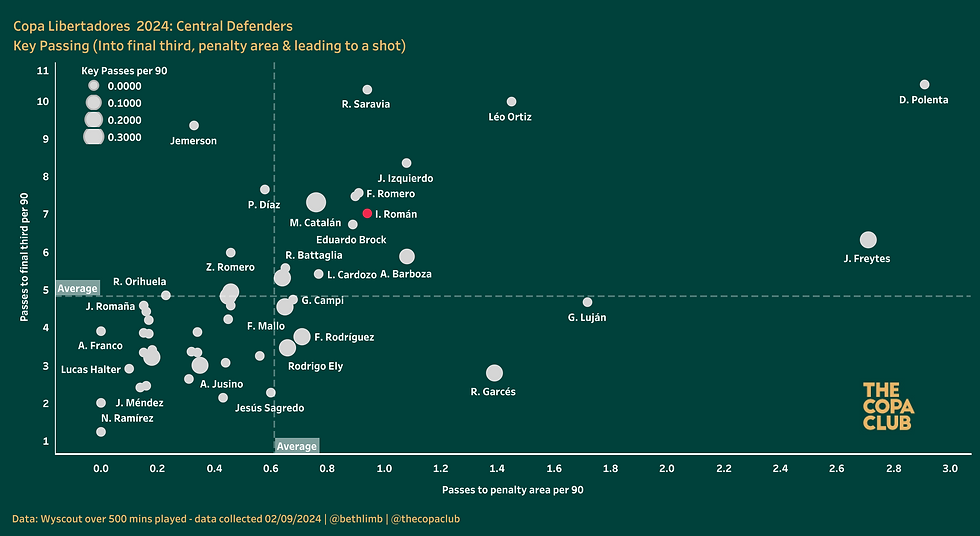
Looking into Román’s key passing in the Copa Libertadores, it is a very similar story (as we would expect). The young defender averaged 7.02 passes into the final third per 90 and 0.94 passes into the penalty area per 90.
Iván Román: In-game analysis
In this section of our scout report, we will review in-game footage of Iván Román to gain a more comprehensive understanding of his abilities in and out of possession. We will use this to form a well-rounded view of Román as a player and make a projection about his future.
Ball progressor

We will begin by looking into Román’s ball progression since we firmly established this is a key element of his style of play via our data analysis.
In this image, Román, who is incredibly high up the pitch, plays a progressive pass in the right-half space for his teammate who makes a run in behind the opposition’s defensive line.
Firstly, Román clearly has the freedom to step out of the defensive line and push high into the opposition's half when Palestino are in possession. Not only does this mean that he can get into optimal passing positions, which allow him to play these passes in behind but also means that he is on hand to recycle possession should Palestino be unable to work an opening at the first attempt.

The heatmap above shows us that Román often ventures into the opposition half, mostly positioning himself just beyond the halfway line. He also tends to drift towards the wide-area a lot, potentially creating overloads on the right side.
Palestino typically lines up in a 4-3-3 or 4-2-3-1 system so Román’s willingness to position himself wide on the right in attack allows him to link up with the fullback who has the freedom to push forward and the right winger or one of the midfielders.
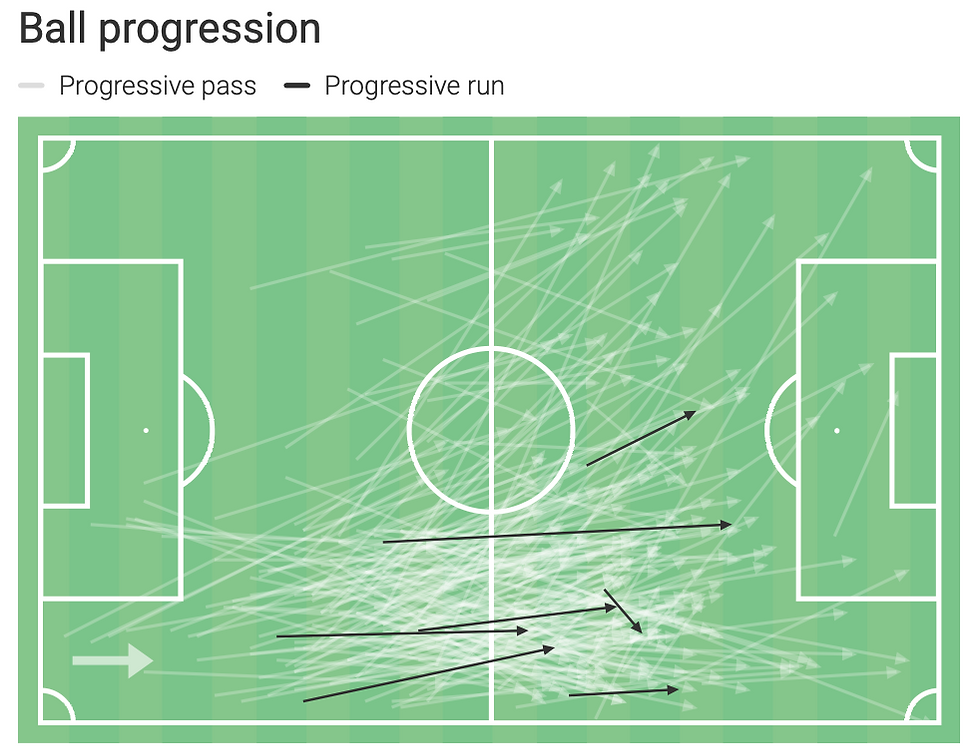
This image demonstrates where on the pitch Román’s progressive actions occur. He executes a wide range of progressive passes, some being utilised as switches of play out to the left.
Most though, are into that right half space or the final third as we suspected from our data analysis. Additionally, his progressive runs mostly begin inside his own half, driving into the opposition half.

On this occasion Román carries the ball forward deep into the opposition half. This time, he plays a short pass into the feet of his teammate who turns and drives at the opposition.
Once he has released the pass, Román doesn’t stay still or look to drop back into a more defensive position. He continues his forward run off the ball and moves into the opposition penalty area.
This demonstrates his willingness to contribute to the attacking phase of play, it is clearly part of the tactical instruction at Palestino, giving him the prerogative to be creative.
Of course, there is a risk attached, with a central defender so high up, there needs to be adequate cover in case of turnovers and counterattacks but overall, Román seems to enjoy the freedom he is given.
Defending on the front foot

Our data analysis showed us that Román is a central defender who is very proactive and likes to play on the front foot - we can see that in action here.
In this instance, the opposition recovered possession and launched a long pass upfield, looking for one of their attacking players. Recognising there is the possibility of recovering possession for his team, Román utilises the wonderful burst of acceleration that he has in his locker to reach the intended target of the pass.
Then, using his physical strength he manoeuvres the opposition player out of the way, ensuring he gets his foot to the ball first. Plus, he manages to direct the ball towards his teammate, further increasing the opportunity for Palestino to counterattack.

Román is also very proactive at dealing with crosses. On this occasion, reading the game and recognising the danger, he comes across to help out his teammate. He uses his body shape well to close down the passing lane into the penalty area.
He then forces the opponent close to the byline where he is calmly able to block the cross, nullifying the threat to his team. It has to be said that the 18-year-old shows a level of maturity in his decision-making that makes you forget just how young he is.
Aerial issues


We have to acknowledge Román’s biggest weakness, which is his aerial ability. These images depict the defender in two aerial situations, one where he is running back to his own goal, and the other where he is looking to clear the danger from a long throw.
Upon watching several in-game situations similar to this, we were able to make a couple of observations. Firstly, he doesn’t actually possess a very good jumping reach. Román struggles to generate enough power through his legs to leap above his opponent which means he is less likely to win aerial duels.
Secondly, his positioning going into the duels is not always the best. In the first image, he has misread the bounce of the ball and finds himself caught under the ball when attempting to win the aerial battle. As a consequence, the opponent is able to put him under pressure causing him to miss the header altogether.
Interestingly, when he does win the aerial battle, Román can then find it difficult to direct his headers towards a teammate. One reason for this is that mistiming his jumps is quite a common occurrence in his game.
In the second image, he wins the duel but as he has mistimed the jump, he connects with the ball when he is on a downward trajectory meaning it hits him on top of his head rather than connecting with the ball at the highest point of his leap.
Covering

Covering is a vital part of the defensive phase of play as it allows a team to maintain defensive solidity and prevent the opposition from exploiting gaps in their defensive line.
Cover is provided by defenders reading the game well, recognising when the opposition is looking to play passes in behind their line and anticipating their distances appropriately, dropping back to act as a safety net for their team.
Here, we can see Palestino in their 4-3-3 defensive structure. He is in an optimal position should he need to drop back to prevent the opponent from running in behind the defensive line.

As soon as the opponents work the ball into midfield, he drops back and shapes his body well, ready to accelerate into the space where the ball will be played in order to prevent his opponent from going through 1v1 with the ‘keeper.
That initial step back allows the centre-back to better anticipate and react to the movements of opposing attackers. By staying a step behind, he can monitor the run of the striker and ensure he can get into an optimal position to intercept/recover the ball or block their run.
Conclusion
This has been a pretty comprehensive look into Iván Román’s strengths and weaknesses on the pitch.
We used our initial percentile rankings to build an overview of his style of play before diving into a much deeper data analysis to compare his performances on the domestic and continental stages.
Finally, we used in-game footage to further our scout report and identify the key areas of his game.
Overall, the Chilean defender is a very exciting player, he is incredibly calm and composed on the ball and his reading of the game is exceptional. Yes, there are issues with his aerial ability but on the whole, he is a very exciting prospect.
Latest Podcast with Kevin Hatchard
Catch up on our latest podcast with Bundesliga commentator and European football expert Kevin Hatchard as we dive into some of the biggest talking points.
Comments